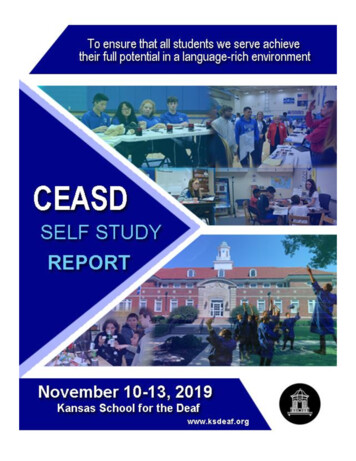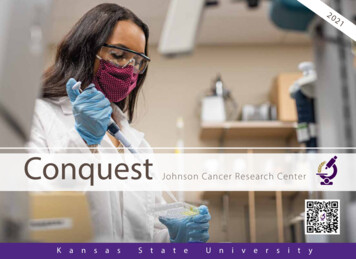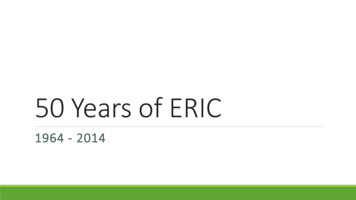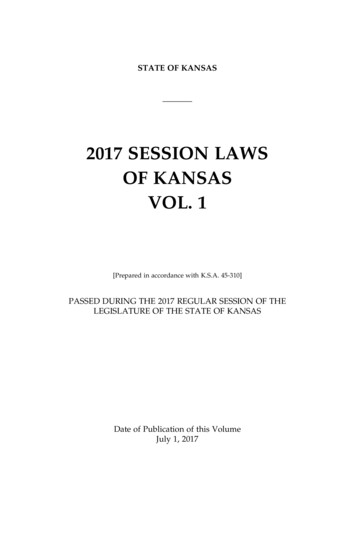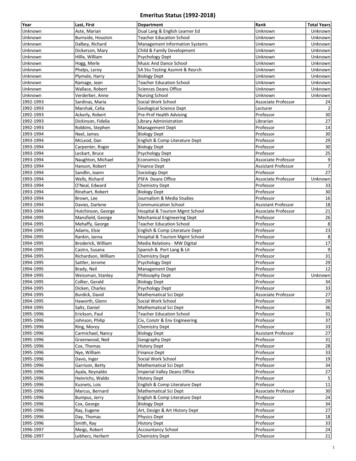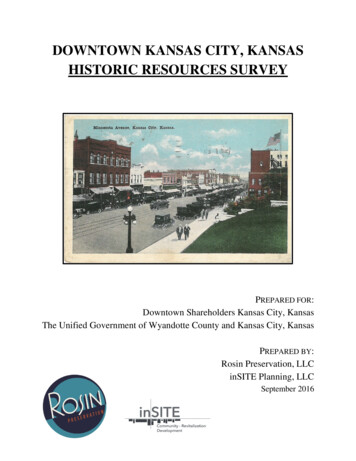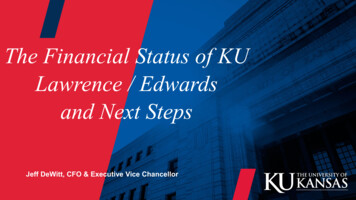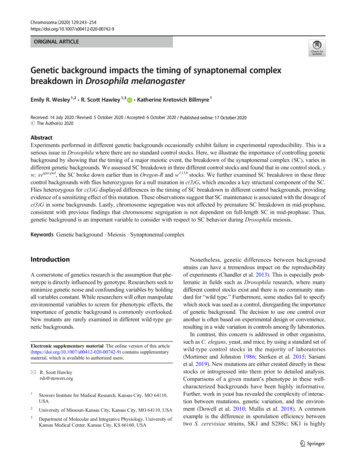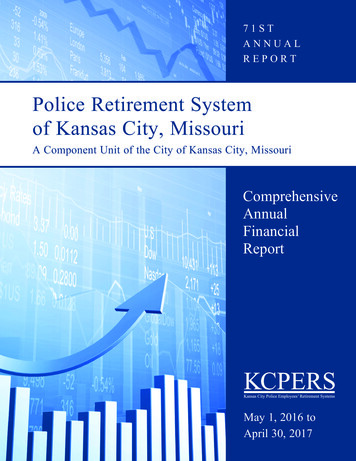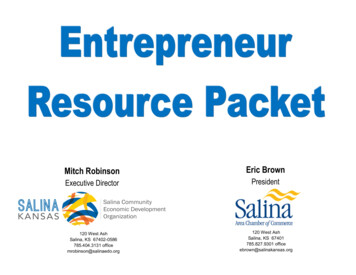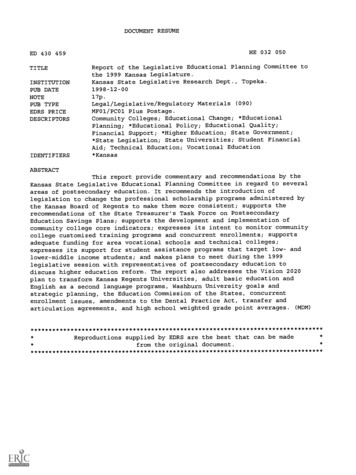
Transcription
DOCUMENT RESUMEHE 032 050ED 430 459TITLEINSTITUTIONPUB DATENOTEPUB TYPEEDRS PRICEDESCRIPTORSIDENTIFIERSReport of the Legislative Educational Planning Committee tothe 1999 Kansas Legislature.Kansas State Legislative Research Dept., Topeka.1998-12-0017p.Legal/Legislative/Regulatory Materials (090)MF01/PC01 Plus Postage.Community Colleges; Educational Change; *EducationalPlanning; *Educational Policy; Educational Quality;Financial Support; *Higher Education; State Government;*State Legislation; State Universities; Student FinancialAid; Technical Education; Vocational Education*KansasABSTRACTThis report provide commentary and recommendations by theKansas State Legislative Educational Planning Committee in regard to severalareas of postsecondary education. It recommends the introduction oflegislation to change the professional scholarship programs administered bythe Kansas Board of Regents to make them more consistent; supports therecommendations of the State Treasurer's Task Force on PostsecondaryEducation Savings Plans; supports the development and implementation ofcommunity college core indicators; expresses its intent to monitor communitycollege customized training programs and concurrent enrollments; supportsadequate funding for area vocational schools and technical colleges;expresses its support for student assistance programs that target low- andlower-middle income students; and makes plans to meet during the 1999legislative session with representatives of postsecondary education todiscuss higher education reform. The report also addresses the Vision 2020plan to transform Kansas Regents Universities, adult basic education andEnglish as a second language programs, Washburn University goals andstrategic planning, the Education Commission of the States, concurrentenrollment issues, amendments to the Dental Practice Act, transfer andarticulation agreements, and high school weighted grade point averages. ***********************************Reproductions supplied by EDRS are the best that can be madefrom the original ***************************************
JOINT COMMITTEESLflReport of theLegislative Educational Planning Committeeto the1999 Kansas LegislatureCHAIRPERSON: Representative Cindy EmpsonVICE-CHAIRPERSON: Senator Barbara LawrenceOTHER MEMBERS: Senators Christine Downey, Audrey Langworthy, Janis Lee, and LanaOleen; Representatives Barbara Ballard, Deena Horst, Kay O'Connor, Richard Reinhardt, andJonathan WellsPERMISSION TO REPRODUCE ANDDISSEMINATE THIS MATERIAL HASBEEN GRANTED BYBen BarrettTO THE EDUCATIONAL RESOURCESINFORMATION CENTER (ERIC)1U.S. DEPARTMENT OF EDUCATIONOffice of Educational Research and improvementEDUCATIONAL RESOURCES INFORMATIONCENTER (ERIC)6/This document has been reproduced asreceived from the person or organizationoriginating it.0 Minor changes have been made toimprove reproduction quality.Points of view or opinions stated in thisdocument do not necessarily representofficial OERI position or policy.2December 1998BESTCOPY AVAILABLE
LEGISLATIVE EDUCATIONALPLANNING COMMITTEEPLANNING FOR POSTSECONDARY EDUCATION*CONCLUSIONS AND RECOMMENDATIONSThe Committee recommends the introduction of legislation that makes changes to the professionalscholarship programs administered by the Kansas Board of Regents to make them more consistent;supports the recommendations of the State Treasurer's Task Force on Postsecondary Education SavingsPlans; supports the development and implementation of community college core indicators; expressesits intent to monitor community college customized training programs and concurrent enrollments;supports adequate funding for area vocational schools and technical colleges; expresses its support forstudent assistance programs that target low- and lower-middle income students; and makes plans to meetduring the 1999 Legislative Session with representatives of postsecondary education to discuss highereducation reform.with the State Board of Education and individualschool districts to specify a precollege curriculumthat will meet Board approval.BACKGROUNDThe Legislative Educational Planning Committee (LEPC) is a statutorily-authorized committee charged with planning for public and privatepostsecondary education in Kansas. The Committee may initiate its own studies, in addition toproposals assigned by the Legislative Coordinating Council. Among the items reviewed by theCommittee during the 1998 interim were professional scholarship programs, which are the subject of legislation recommended for introductionduring the 1999 Session. All items studied by theAs of the end of the 1998 interim, the KansasBoard of Regents reports that, of the 353 publichigh schools in Kansas, only 26 have not imple-mented an approved precollege curriculum.Those high schools that have not implementedthe curriculum currently are working with theBoard's staff, which expects all schools to havecomplied by February 1, 1999. There is no publichigh school that is not working on implementingCommittee are reviewed in the material thatthe curriculum. In addition, 22 of the state's 23follows.private accredited high schools have either implemented or are working to implement the curriculum.Regents Institutionsby the 1996 Legislature requires that admissionsCommittee Comment. The Committee hasfollowed the implementation of qualified admissions with interest and is pleased that all of thestandards be imposed on freshmen enteringpublic and almost all of the private accreditedRegents institutions, beginning with school year2001-2002. Since the legislation was enacted, theOffice of the Board of Regents has been workinghigh schools in Kansas either have met theQualified Admissions. Legislation enactedprecollege curriculum guidelines or are in theprocess of meeting them. According to staff of* H.B. 2014 was recommended by the Committee.6-1
the Board of Regents, some of the schools forabout change in each of the areas and indicatesthe timeline for when the change will be com-which approval is pending are waiting for aPerformance data will be used in theprocess to measure how well the institutionsuniversity to evaluate their curriculum (one of thesteps in the process) or are working with the staffpleted.on the matter of how to categorize computerachieve their goals. The five areas are the follow-courses that are integrated into other courses.ing:The Committee wants to recognize the1.efforts the staff of the Kansas Board of Regentshas made to work with the high schools and, inparticular, commend it for the tact with which ithas handled potentially sensitive issues, such asmedia interest in progress being made by schools.The staff has been professional, open, and help-2.3.4.5.fulqualities that have helped schools meet thebegan an eight-year cycle of academic programgoals of the legislation and have kept the Legisla-review.curriculum and instruction,faculty time and talent,faculty development, support, and rewards,operations and support processes, andfinancingIn addition, in 1997 the Board of Regentsture and the public informed about the implementation of this important public policy. TheRegents Peer Institutions. Twenty yearsago, the Board of Regents decided to identifypublic institutions across the country that areCommittee also commends the high schools thathave worked hard to meet deadlines and betterprepare their students to do college-level work.comparable to each of the Regents universities inorder to have an objective benchmark againstwhich to measure funding levels for the Kansasschools. The institutions were to be enough likethe Regents universities that comparisons were"Vision 2020." The Committee received areport from the Kansas Board of Regents regarding its initiative, Vision 2020: Transforming theKansas Regents Universities for the 21st Century.meaningful, not institutions that enjoy such highlevels of funding that comparisons to Kansas areunrealistic. The criteria used to select these"peer" institutions included location in states thatare similar to Kansas in terms of population andincome and institutions that are similar in termsof enrollment and program emphasis. Separatepeer groups were selected for the University ofThe impetus for change is circumstances thatcould affect the ability of the Regents institutionsto provide high quality, accessible programs at areasonable cost to students. Those circumstancesinclude:resource constraints and increased competition for public funds;Kansas, Kansas State University, and WichitaState University, and a common peer group wasan increasing demand for services and achange in the mix of services needed, such ascustomized programs for specific groups ofstudents, nontraditional service deliveryformats, and services for place-bound adults;selected for Emporia State University, Fort HaysState University, and Pittsburg State University.technological and economic changes thatinfluence how students learn and their de-funded at 81.1 percent of their peers. This statis-mand for workforce training; andan increasing demand for accountability inthe use of resources and responsiveness topublic expectations.because it means that faculty salaries in Kansas areIn FY 1996, the Regents institutions weretic causes concern among Kansas universitiesnot competitive, which contributes to facultymembers leaving Kansas to take university posi-tions in another state. To address this concern,the Kansas Board of Regents is compiling data tosupport a three-year funding proposal to increasefaculty salaries to the levels of the peers.To address these challenges, the Kansas Boardof Regents has identified five key areas for changeand has directed each campus to develop a planthat identifies what steps it will take to bring6-2
Fort Hays State University Distance Learning Initiative. Interest in academic extension anddistance learning prompted the Committee to ask3.4.5.6.7.8.the President and staff from Fort Hays StateUniversity to report on current activities. FortHays has been actively involved in distancestudent performance,measurement of critical skills,client assessment of programs and services,student success in subsequent related courses,use of technology in teaching and learning,linkages between K-12 and postsecondaryeducation,9. attainment of affirmative action or diversitylearning for the past ten years and currently offers180 courses that serve more than 900 studentswho will be able to get degrees without evergoals,stepping on the Fort Hays campus. Other insti-10. evaluation of Adult Basic Education, Generaltutions are making similar efforts to provideEducation Development, and English as adistance learning opportunities, but Fort Hays, inparticular, has focused its resources in this areaSecond Language programs,11. student demonstration of mastery of programoutcomes,12. participation rate in service area, andand provides services to all parts of WesternKansas, including Oberlin, Colby, Great Bend,Dodge City, Garden City, Liberal, and Elkhart,which is almost 230 miles from the Fort Hays13. access.Students prefer distance educationbecause it is convenient, flexible, adaptable toThe intention of the task force was to implement indicators 1 through 5 by May 1999; indicators 6 through 8 by May 2000; and indicators 9through 13 by May 2001. The recommendationscampus.learning style preferences, and may even allow forgreater interaction than traditional deliverysystems. The Committee was told to expectof the task force were presented to the StateBoard of Education in November. The Statelearning in the future to be less reliant on printedmaterial and traditional classrooms and moreoriented toward portable and modular deliveryBoard generally endorsed the recommendations,formats. The message from the Fort Hays representatives was that in the future instructional andsupport services will be based on the convenienceof the consumers, not that of campus constituen-indicators will be implemented will be differentfrom the task force's recommendation. The StateBoard also assigned a staff position in the Statecies.community colleges to begin designing the datacollection system. A committee of communitycollege representatives also is working with theState Department.although it is possible the order in which theDepartment of Education to work with theCommunity CollegesCommittee Comment.Community College Core Indicators. InThe Committeestrongly supports the initiative of the community1997, the Council of Presidents of the KansasAssociation of Community College Trusteescolleges to develop a common database and ispleased that the State Board of Education hasendorsed the project. The Legislature is becom-formed a task force comprised of college represen-tatives, two state legislators, and a communitycollege trustee. The charge to the task force wasing increasingly interested in ways to assess howto develop a data management system that wouldallow the community colleges to collect, aggregate, and report information that could be used tomeasure the colleges' success in meeting their rolewell public institutions perform their role. Thedevelopment of performance indicators, and auniform data management system built aroundthose indicators, will make the institutions moreand mission. The following 13 core indicatorswere identified, for which data will be collectedaccountable and could lead to the development ofa funding mechanism that enhances quality. TheCommittee urges the State Board and the commu-and reported:nity colleges to proceed with this worthwhileendeavor.student goal attainment,2. student satisfaction,1.6-3
Committee Comment.Customized Training Programs. ConcernsThe Committeeraised during the 1998 Session about customizedtraining programs offered by community collegesprompted an audit by the Legislative Division ofsupports the resolve of the State Board of Educa-Post Audit and review of the programs by twointerim committees. Attention focused mainlyremain frustrated at what they consider thetion to strengthen its control over customizedtraining programs, although some membersunderlying circumstance that has contributed tothe situation: a funding system that forces community colleges to rely almost entirely on credithours generated and fails to provide alternativefunding to adequately support customized train-on customized vocational training courses offeredby Dodge City Community College for workersat two beef processing plants. The communitycollege offered the courses, taught by employeesof the companies, at the beef processing plantsusing the plants' equipment and facilities. Undering activities.The Committee intends to monitor thethe arrangement the community college had withthe plants, the plants paid student tuition for theiremployees and the institution paid the plants rentfor equipment and facilities that exactly equaledimplementation of the State Board's guidelinesand plans to review customized training activitiesduring the 1999 interim. In this connection, theCommittee acknowledges the recommendationsof the Joint Committee on Economic Development, which also reviewed the issue, and concurswith its request that the State Board keep variousthe amount of tuition paid. In addition, thecommunity college paid the plants for instructorfees. Because the program was approved by theState Department of Education, state aid in thelegislative committees, including the LEPC,informed of its activities related to customizedform of credit hour aid (paid at the rate of 2.0times the rate for academic hours) and out-districtstate aid was paid. Dodge City accounted for 87training.percent of the 2.1 million paid in state aid forPostsecondary Education Planning Goalsfor 1998-2000. The Committee reviewed plan-customized training courses in FY 1997.The post audit concluded that the arrange-ning goals the State Board of Education hasment was legal, but was characterized by a lack ofadopted that relate to community colleges, areavocational schools, and technical colleges. Thegoals generally pertain to activities over the nextgood control on the part of the State Board ofEducation. The State Board responded in November of 1998 by approving guidelines thataddress the concerns raised by the post auditorstwo years, although some will take longer toimplement. Various committees have beenappointed to work with the State Department tohelp define and implement the goals. Some of themajor goals are the following:and tighten the State Department's administrationof the customized training program to be surethat all guidelines have been met. The guidelinesalso require that the faculty of customized training courses have a clear employment relationshipThe statutory definition of "credit hour" forcommunity colleges should be revised torecognize that learning takes place in wayswith the educational institution and explicitlystate that the amount of money paid by a businessin the form of tuition and fees may not be offsetby money paid back to the business by the educa-other than "seat time."The proposed system to measure communitytional institution in the form of rent or paymentfor instructional services. In addition, the Dodgecollege core indicators should be imple-City Community College Board of Trusteesin area vocational schools and technicaldiscontinued the institution's customized trainingactivities with the beef packing companies underthe prior arrangement in September of 1998. Thecommunity college will continue to offer custom-colleges should be developed.Distance learning guidelines should be developed.ized training courses under the new guidelinesapproved by the State Board.creased and a new funding system for capitalimprovement projects should be developed.mented and benchmarks to measure qualityTechnology grant funding should be in-6-4
A strategic plan for technical education andThe Committee received a report from the Deanworkforce development should be developed.Community college standards for concurrentenrollment should be developed.of Students at Neosho County CommunityCollege that Neosho County and CoffeyvilleCommunity Colleges have received a five-yeargrant totaling 190,000 under the federal talentsearch program. The program identifies andAdult Basic Education and English as aSecond Language Programs. Reports werepresented to the Committee about Adult BasicEducation and English as a Second Languageassists high school students from disadvantagedbackgrounds who have the potential to succeed incollege. Academic, career, and financial counseling is provided to encourage students to graduatefrom high school and go to college. Tutorialservices, mentoring programs, workshops, andinformation about postsecondary institutions areprovided program participants.programs, two activities carried out by commu-nity colleges to help adults function better insociety and prepare for jobs.Adult Basic Education programs are offeredby all 19 community colleges, 12 school districts,St. Marys College, and at three community-basedsites. They serve more than 8,500 adults and arefunded from federal and state funds, with someThe Neosho County-Coffeyville project isexpected to serve about 600 students in sevencounties in Southeast Kansas (Woodson, Allen,local support in the form of an authorized milllevy. Adults are taught basic reading, writing,and mathematics skills in order to get jobs andmay work to obtain general education development (GED) degrees. Evidence indicates thatpublic investment in the program pays off inWilson, Neosho, Chautauqua, Montgomery, andLabette) and Nowata County across the border inOklahoma. Five other four- and five-year talentsearch grants are being funded in Kansas thatinvolve Cowley County, Independence, DodgeCity, and Garden City Community Colleges andthe University of Kansas and Wichita State University. The combined projects will reach 5,000high school students.savings due to program graduates becomingproductive members of society.English as a Second Language programsserved almost 5,000 students and are intended tohelp people find and keep jobs. A secondaryArea Vocational Schools andTechnical Collegespurpose is citizenship preparation. In some cases,services are provided to employers so that theycan communicate with their employees who arelearning to speak English. English as a SecondFunding Issues. The Committee receivedLanguage programs have the same fundingreports from the State Department of Educationabout how funding for vocational capital outlaysources as Adult Basic Education and the twoand technology equipment had been allocated andprograms sometimes are taught together as part offrom representatives of area vocational schoolsand technical colleges concerning ongoing fund-a comprehensive family resource center thatprovides a variety of services. According to theKansas Board of Regents, the number of teacherswho are qualified to teach English as a SecondLanguage programs has increased. Currently,seven public and private institutions in Kansashave teacher preparation programs in that teaching area. They are the Universities of Kansas,Emporia, Kansas State, Wichita State, and FortHays State and Newman College and McPhersoning needs.College.schools totaled more than 6.4 million.The 1998 Legislature approved 3.0 millionfor capital outlay expenditures at area vocationalschools (including community colleges designatedarea vocational schools) and technical colleges.This money will be matched by 1.5 million fromlocal resources and will be used to purchaseinstructional equipment. Requests from theThe 1998 Legislature also approved 1.0Southeast Kansas "Talent Search" Program.6-57
schools and technical colleges appear to eitherhave negotiated a better agreement with theirmillion in grants to area vocational schools andtechnical colleges and 2.0 million to communitycolleges and Washburn University for technologyequipment. Funding to the area vocationalschools and technical colleges does not require alocal match, but the appropriation to the community colleges and Washburn University requires a50 percent local contribution. Requests from thearea vocational schools and technical collegestotaled more than 2.8 million. The communitycolleges and Washburn University requested acombined total of almost 5.2 million.sponsoring districts to educate secondary studentsor charge sending districts a cost-per-hour ofinstruction that covers the services provided.Committee Comment. The Committee haslong been a proponent of adequate support forarea vocational schools and technical collegesbecause it recognizes and values the role theseinstitutions play in providing job training andretraining for Kansas residents. The Committeeencourages the Legislature to generously supportthe state's workforce training effort, withinFor FY 2000, the State Board of Education isrequesting 2.0 million for the vocational educa-available resources. It calls particular attention tothe institutions' plight regarding the lack of directtion capital outlay program, 2.0 million formill levy support for facilities and the limitedamount of state aid, if any, that is available forbuilding construction and repair. Likewise, thetechnology grants to area vocational schools andtechnical colleges, and 2.0 million for technology grants to community colleges and WashburnUniversity.failure of the state to fully fund its share ofpostsecondary area vocational school tuition isshort-sighted because it shortchanges and compro-The Committee also heard concerns aboutthe need of area vocational schools and technicalcolleges for funding for facilities, the need forincreased support for postsecondary area vocational school student tuition, and, in the case ofthe Wichita Area Technical College, the need forgreater funding for secondary students.mises the state's ability to maintain a highlytrained workforce. It also flies in the face ofavowed state policy to provide options to students who want to prepare for an occupation thatdoes not require a baccalaureate degree. (For FY2000, the State Board is requesting an increase ofmore than 6 percent, compared to the 1.8 percentThe need for facilities funding is due to areavocational schools and technical colleges, largelybuilt in the 1960s, not having an adequate sourceof funding for buildings and repairs. The needfor adequate state aid for postsecondary studenttuition is based on the fact that the vocational andtechnical schools are meeting increasing demandsincrease approved by the Legislature for FY 1999over FY 1998.) With regard to the Wichitasituation, the Committee considers the arrangement between the Wichita Board of Educationand the technical college a local matter. However, it notes that information provided by theState Department seems to support the contention that the Wichita Area Technical Collegefor job training and retraining for adults and,unless the state pays its 85 percent share ofpostsecondary student tuition, the institutionseither must cut programs or ask sponsoringreceives less funding for secondary students fromits sponsoring district than do any of its counterparts.districts to subsidize programs that enroll adults.Washburn UniversityThe situation in Wichita-the perception thatthere is inadequate funding for secondary studentswho take courses at the technical college-appearsGoals and Strategic Planning. WashburnUniversity has embarked on a series of initiativesto be unique and is due to the governing boardfor the technical college (the USD 259 board ofintended to position the University for the nextcentury, according to its President, Jerry Farley.The direction the University is taking does noteducation) apparently choosing to fund secondarystudents enrolled at the college at a lower ratethan actual program costs. Other area vocationalnecessarily depend upon affiliation with the6-68
changes. No action was taken on the bill and asubcommittee of the Senate Ways and MeansRegents' system, but instead seeks a stable andenhanced state funding base upon which to build.Activities include a three-year review of programsCommittee recommended that the bill be studiedduring the interim.intended to align resources with the programsthat are most important to the institution'smission. Other initiatives include an intensiveleadership program to prepare students to fillleadership roles in the public and private sector;The Kansas Board of Regents administers anumber of scholarship programs for personsentering specific professions that have a servicecomponent whereby, for each year a scholarshipis received, the practitioner must work one yearin the profession or else must pay back the scholarship. The scholarships affected by the bill arethe Kansas Nursing Student Scholarship Program,the Osteopathic Scholarship Program, theTeacher Scholarship Program, and the Optometry Education Program.two-plus-two programs with Johnson County andKansas City, Kansas Community Colleges; andprograms to help students succeed in college.The programs for student success involve theCenter for Learning and Student Success (CLSS)that helps students develop study skills, providesaccess to advisors and computers, and makesspecific classes available, and the "Prescription forA unique feature of the Nursing StudentStudents in theFreshman Success program take prescribedFreshman Success" program.courses and are limited to 12 hours per semesterfor the first year. They also are given intensiveadvising and get help from tutors. Those who doScholarship Program is the sponsorship component, which requires each nursing student whoreceives a scholarship to have a sponsora medicalcare facility, psychiatric hospital, or adult carewell after the first year are taken out of thehometo provide a scholarship match to theprogram and proceed with their college careers asregular students.nursing student in an amount equal to the state'scontribution. Pursuant to an agreement with thesponsor, the nursing student must agree to workCommittee Comment. The Committeecommends Washburn University and Dr. Farleyfor the initiatives being taken to make the University a viable institution in the years to come.In particular, the Committee is impressed withthe programs the University had developed tohelp students do well in college. Not only willthese programs avoid wasting public funds andstudent tuition on unsuccessful college careers,for the sponsor for each year a scholarship isbut, more importantly, they will conserve andnurture human resources by helping all studentsof a match.benefit from college educations. The Committeeintends to watch with interest the implementation of these programs.Association oppose the elimination of the spon-received.A controversial feature of the proposed billwould have eliminated the sponsorship feature,apparently because not enough hospitals andother facilities are willing to sponsor a nursingstudent. As a result, some state money for nursing scholarships is not allocated because of a lackRepresentatives of the KansasNurses' Association and the Kansas Hospitalsorships because they believe the program isworking well and commits nurses to work forhospitals and other health care facilities after theygraduate, thereby helping the facilities get theStudent Financial Assistancenurses they need.Professional Scholarship Programs. Legislation was introduced during the 1998 Session (H.B.In order to work out an agreement acceptableto the parties involved, the Committee asked the2753) that would have made some of the provisions of certain professional scholarship programsstaff to meet with staff from the Office of theBoard of Regents and representatives of theadministered by the Kansas Board of Regentsconsistent and would have made other policyaffected professions to make recommendations tothe Committee concerning desired changes. The6-7
Committee also wanted the Ethnic Minorityteachers to parts of the state where they areFellowship P
State University, and Pittsburg State University. In FY 1996, the Regents institutions were. funded at 81.1 percent of their peers. This statis-tic causes concern among Kansas universities. because it means that faculty salaries in Kansas are. not competitive, which contributes to faculty. members leaving Kansas to take university posi-
